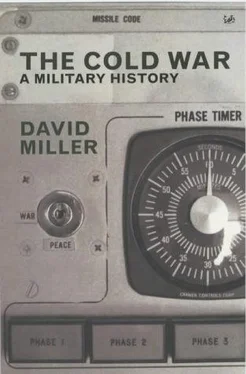Even without such classified sources, the Federal German News Service was able to establish that by the end of July some twenty Warsaw Pact divisions were lining the Czech frontiers and that their plan was to drive a wedge straight across the country, with the aim of dividing the fourteen divisions of the Czech army into two.
The evidence of a probable invasion accumulated rapidly, and on 18 August Western radio monitoring units reported that all Warsaw Pact units near the Czechoslovak border had gone on to radio silence – usually an accurate portent that something was about to happen. Then, at 2311 hours precisely on Sunday 20 August, Western radar monitors detected that Prague airspace had suddenly been blanked out on their screens by artificial ‘snow’. [4]The situation was made worse for the West because the whole of eastern Europe was also being protected naturally by a dense and widespread layer of cloud, which could not be penetrated by the sensors aboard US spy satellites.
A major external factor, which affected the US forces in western Europe closely, was the situation in South Vietnam, where the war was at its height; the US armed forces had some 530,000 troops deployed there, and suffered 14,437 deaths during 1968. That year was the year of the Communist Tet offensive (30 January to 29 February), which was subsequently shown to have been a major Communist defeat, but at the time it had a very adverse political and public-relations impact in the United States. Having failed at Tet, the North Vietnamese mounted a second, short-lived, offensive in May, and then a third, which involved attacks all over South Vietnam, on 17 August. That this came just four days before the Warsaw Pact invasion of Czechoslovakia may well have been more than mere coincidence. However, the fact was that in Washington the attention was predominantly on events in Vietnam, while in western Europe many individuals and units had been withdrawn from the US Seventh Army to serve in Indo-China.
NATO appears to have ignored all these warnings; for example, SACEUR (General Lemnitzer) departed to visit exercises two days before the invasion and was in Greece on the day it took place. One possible alternative, supported by unconfirmed rumours at the time, is that the commander of the Warsaw Pact operation, Soviet general I. G. Pavlovsky, warned Western commanders of the forthcoming operation and gave them a believable assurance that there was no hostile intent towards the West.
Even if this report were true, the fact is that some forty Warsaw Pact divisions were on the move; had they simply kept moving and rolled across the Czechoslovak border into the Federal Republic, NATO was in no position to have resisted. NATO troops in western Europe were on the lowest stage of alert, and it would have taken US reinforcements several weeks or more to have reached Europe from the USA, by which time the fighting might well have overrun the airfields they were intending to use. [5]
Publicly at least, the NATO reaction was merely one of words, with the North Atlantic Council, for example, stating in November 1968 that:
World opinion has been profoundly shocked by this armed intervention carried out against the wishes of the Government and people of Czechoslovakia…. The contention of the Soviet leadership that there exists a right of intervention in the affairs of other states deemed to be within the so-called ‘Socialist Commonwealth’ runs counter to the basic principles of the United Nations Charter, is dangerous to European security and has inevitably aroused grave anxieties… {3}
Internally, however, NATO carried out a serious and deep analysis of its failings. It revised its crisis-management procedures, both within the organization itself and in the national capitals. It also reviewed its force structure, its force strengths and its mobilization and reinforcement procedures. It also had to face a major change in the Warsaw Pact’s deployments, because a number of Soviet divisions remained in western Czechoslovakia, where there had been none before.
The INF (intermediate-range nuclear forces) crisis was one of the most important ever to hit NATO. It started in about 1974, when NATO members began to see a steady build-up of a new Soviet intermediate-range ballistic missile, [6]the SS-20. This was seen to be a major attempt by the USSR to alter the balance in this field in its favour and thus pose a major threat to western Europe. In consequence, the Alliance reacted with a vigour some had begun to doubt it possessed; indeed, the SS-20 played a key role in the eventual demise of the Soviet Union and the Warsaw Pact.
Intermediate-range nuclear forces had not been a major issue up to that time. NATO itself had deployed some US IRBM systems in Europe between 1959 and 1965, comprising sixty Thors in the UK and sixty Jupiters, thirty of which were based in Italy and thirty in Turkey. Their operational lives were, however, very brief, since all were phased out in 1965: the British Thors because they were sited in the open and were too vulnerable to a Soviet first strike, while the withdrawal of the Jupiters from southern Europe was part of the Cuban Missile Crisis settlement.
The Soviet IRBMs remained, however, and throughout the 1960s and 1970s NATO seemed tacitly to accept the existence of a large number of IRBMs sited in the USSR’s western military districts and clearly targeted on NATO countries. These missiles were of two types, the older being the SS-4, which entered service in 1957 and carried a single 1 MT warhead, [7]while the SS-5 entered service in 1961 in two versions: Mod 1, with a single 1 MT warhead, and Mod 3, with three 300 kT warheads. Most of these were deployed in missile fields just to the east of the Soviet–Polish border, and at their peak in the late 1960s some 700 were in service, reducing to approximately 400 in the mid-1970s. The SS-4 had a range of some 2,000 km, while that of the SS-5 was 4,100 km, which enabled both missiles to cover the whole of western Europe, although their relative inaccuracy (the SS-4 had a CEP (see Chapter 7) of 2.4 km, while that of the SS-5 was 1 km) meant that they could be targeted only against cities or other area targets.
The existence of two new missiles, the SS-16 and the SS-20, became known in the West in the late 1960s. Both could be launched either from silos or from wheeled transporter–erector–launcher (TEL) vehicles, but there was an even more significant relationship between the two, since they shared two identical missile stages. The SS-20 was a two-stage missile with a range of 5,000 km and carrying three 150 kT warheads with an accuracy (CEP) of 400 m. The SS-16 carried a single 1 MT warhead and was essentially an SS-20 with an additional third stage, giving it a range of 9,000 km. This range meant that the SS-16 was classified as an ICBM and was covered by the SALT treaty, whereas the SS-20 was an IRBM and thus was not covered by SALT.
The SS-20 was road-mobile, using a single twelve-wheeled TEL vehicle, housed in a purpose-built shelter with a split roof which could be opened to allow the missile to be launched. Later, when they signed the INF Treaty in December 1987, the Soviets admitted that they had deployed 650 SS-20 missiles, plus a further forty-two for training. These had been operated by ten missile divisions: six in the western USSR and four in Asia. These divisions included forty-eight regiments, each with its own operating base, which included a number of individual missile shelters with a number of pre-surveyed launch sites in the surrounding area.
These two missiles posed three problems for NATO. US concern centred on the fact that it would be possible for the Soviet Union to manufacture two-stage missiles (i.e. SS-20s) and, quite separately, to also manufacture and store third stages. The verification measures then under discussion would not have been able to differentiate between them, meaning, so the US argued, that at a time of crisis it would be possible to bring these two elements together to create SS-16 ICBMs and thus directly threaten the USA. Following intense discussions in the SALT II negotiations, the agreement included the termination of both testing and deployment of SS-16s.
Читать дальше












